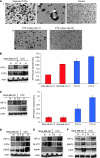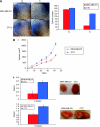Circulating tumour cells demonstrate an altered response to hypoxia and an aggressive phenotype
- PMID: 20051957
- PMCID: PMC2805847
- DOI: 10.1038/sj.bjc.6605491
Circulating tumour cells demonstrate an altered response to hypoxia and an aggressive phenotype
Abstract
Background: Tumours contain hypoxic regions that select for an aggressive cell phenotype; tumour hypoxia induces metastasis-associated genes. Treatment refractory patients with metastatic cancer show increased numbers of circulating tumour cells (CTCs), which are also associated with disease progression. The aim of this study was to examine the as yet unknown relationship between hypoxia and CTCs.
Methods: We generated human MDA-MB-231 orthotopic xenografts and, using a new technology, isolated viable human CTCs from murine blood. The CTCs and parental MDA-MB-231 cells were incubated at 21 and 0.2% (hypoxia) oxygen, respectively. Colony formation was assayed and levels of hypoxia- and anoxia-inducible factors were measured. Xenografts generated from CTCs and parental cells were compared.
Results: MDA-MB-231 xenografts used to generate CTCs were hypoxic, expressing hypoxia factors: hypoxia-inducible factor1 alpha (HIF1alpha) and glucose transporter protein type 1 (GLUT1), and anoxia-induced factors: activating transcription factor 3 and 4 (ATF3 and ATF4). Parental MDA-MB-231 cells induced ATF3 in hypoxia, whereas CTCs expressed it constitutively. Asparagine synthetase (ASNS) expression was also higher in CTCs. Hypoxia induced ATF4 and the HIF1alpha target gene apelin in CTCs, but not in parental cells. Hypoxia induced lower levels of carbonic anhydrase IX (CAIX), GLUT1 and BCL2/adenovirus E1B 19-KD protein-interacting protein 3 (BNIP3) proteins in CTCs than in parental cells, supporting an altered hypoxia response. In chronic hypoxia, CTCs demonstrated greater colony formation than parental cells. Xenografts generated from CTCs were larger and heavier, and metastasised faster than MDA-MB-231 xenografts.
Conclusion: CTCs show an altered hypoxia response and an enhanced aggressive phenotype in vitro and in vivo.
Figures




References
-
- Airley RE, Loncaster J, Raleigh JA, Harris AL, Davidson SE, Hunter RD, West CM, Stratford IJ (2003) GLUT-1 and CAIX as intrinsic markers of hypoxia in carcinoma of the cervix: relationship to pimonidazole binding. Int J Cancer 104: 85–91 - PubMed
-
- Ameri K, Hammond EM, Culmsee C, Raida M, Katschinski DM, Wenger RH, Wagner E, Davis RJ, Hai T, Denko N, Harris AL (2007) Induction of activating transcription factor 3 by anoxia is independent of p53 and the hypoxic HIF signalling pathway. Oncogene 26: 284–289 - PubMed
-
- Ameri K, Harris AL (2008) Activating transcription factor 4. Int J Biochem Cell Biol 40: 14–21 - PubMed
-
- Ameri K, Lewis CE, Raida M, Sowter H, Hai T, Harris AL (2004) Anoxic induction of ATF-4 through HIF-1-independent pathways of protein stabilization in human cancer cells. Blood 103: 1876–1882 - PubMed
Publication types
MeSH terms
Substances
Grants and funding
LinkOut - more resources
Full Text Sources
Other Literature Sources
Miscellaneous

